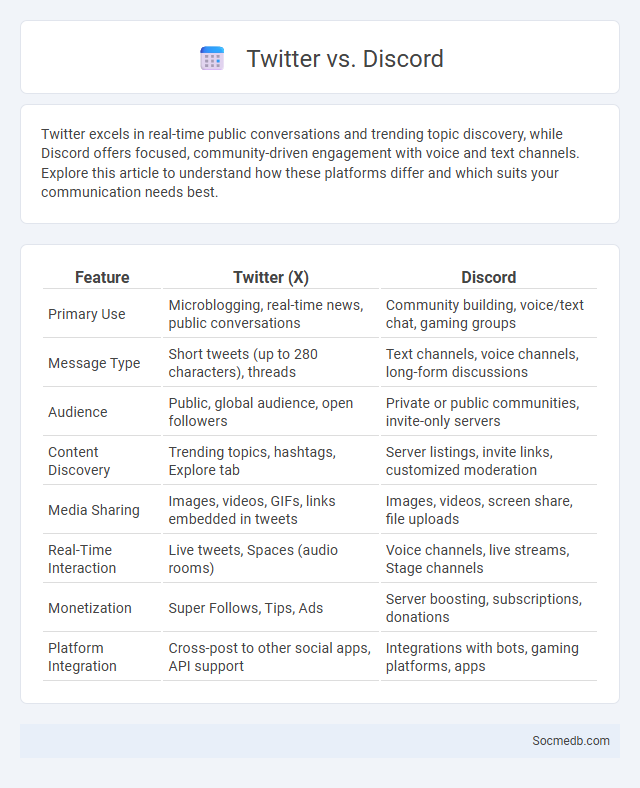
Photo illustration: Twitter vs Discord
Twitter excels in real-time public conversations and trending topic discovery, while Discord offers focused, community-driven engagement with voice and text channels. Explore this article to understand how these platforms differ and which suits your communication needs best.
Table of Comparison
| Feature | Twitter (X) | Discord |
|---|---|---|
| Primary Use | Microblogging, real-time news, public conversations | Community building, voice/text chat, gaming groups |
| Message Type | Short tweets (up to 280 characters), threads | Text channels, voice channels, long-form discussions |
| Audience | Public, global audience, open followers | Private or public communities, invite-only servers |
| Content Discovery | Trending topics, hashtags, Explore tab | Server listings, invite links, customized moderation |
| Media Sharing | Images, videos, GIFs, links embedded in tweets | Images, videos, screen share, file uploads |
| Real-Time Interaction | Live tweets, Spaces (audio rooms) | Voice channels, live streams, Stage channels |
| Monetization | Super Follows, Tips, Ads | Server boosting, subscriptions, donations |
| Platform Integration | Cross-post to other social apps, API support | Integrations with bots, gaming platforms, apps |
Overview: Twitter, Discord, and Tips Compared
Twitter serves as a microblogging platform designed for real-time news sharing and public conversations, with over 400 million active users engaging in concise posts called tweets. Discord offers a community-driven communication experience, hosting voice, video, and text channels tailored for gamers and interest-based groups, supporting millions of servers globally. For effective social media use, prioritize clear content strategies, engage authentically with audiences, and leverage platform-specific features like Twitter's hashtags and Discord's customizable bots to maximize reach and interaction.
Platform Purpose & Audience Demographics
Social media platforms serve distinct purposes, such as Facebook's focus on connecting friends and family, LinkedIn's emphasis on professional networking, and Instagram's visual storytelling for younger audiences. Audience demographics vary widely: TikTok attracts primarily Gen Z users with short-form video content, while Twitter often engages professionals and news enthusiasts interested in real-time updates. Understanding platform purpose and demographics enables targeted content strategies for effective user engagement.
Key Features Breakdown
Social media platforms offer a diverse range of key features including user profiles for personalized identity representation, real-time content sharing through posts, stories, and live streams, and interactive engagement tools such as likes, comments, and shares. Advanced algorithms curate personalized content feeds, enhancing user experience by prioritizing relevant posts and sponsored advertisements. Integration with multimedia formats and robust messaging systems facilitates seamless communication and networking across global audiences.
User Experience and Interface Differences
Social media platforms differ significantly in user experience and interface design, with Instagram prioritizing visual content through an image-centric grid layout while Twitter emphasizes real-time updates using a text-focused feed. Facebook offers a comprehensive interface integrating multimedia posts, groups, and marketplace features, which can be complex but versatile for varied user interactions. TikTok's interface centers on vertical video scrolling with algorithm-driven content discovery, fostering an immersive, rapid-consumption experience optimized for mobile users.
Community Building Capabilities
Social media platforms enhance community building capabilities by facilitating real-time interaction and fostering connections around shared interests. Features such as groups, events, and direct messaging enable personalized engagement and strengthen user loyalty. Advanced analytics tools help brands understand community dynamics and tailor content to maximize participation and growth.
Communication Styles and Content Formats
Social media platforms support diverse communication styles including visual storytelling, short-form text, live video, and interactive posts, allowing you to engage audiences across multiple formats. Optimizing content for each format--such as impactful images for Instagram, concise updates for Twitter, and longer videos for YouTube--maximizes reach and user interaction. Tailoring your communication style to platform-specific content trends improves message clarity and audience engagement.
Monetization and Tip Systems
Social media platforms have increasingly integrated monetization features such as tip systems, allowing users to financially support content creators directly. Popular services like Twitch, YouTube, and TikTok offer digital tipping options, including virtual gifts, coins, and super chats, which boost creator revenue streams. These mechanisms enhance user engagement and foster sustainable creator economies by incentivizing high-quality content production and active audience participation.
Privacy and Security Considerations
Protecting your personal information on social media platforms is crucial to prevent identity theft and unauthorized access. Strong passwords, two-factor authentication, and regularly updating privacy settings can significantly enhance your account security. Being mindful of the data you share helps safeguard your digital footprint and maintain control over your online presence.
Use Cases: Personal, Professional, and Creator Perspectives
Social media enables personal connections by allowing users to share life moments, maintain relationships, and access communities with shared interests. From a professional perspective, platforms like LinkedIn enhance networking, job searching, and brand building to advance careers. For creators, social media offers tools for content distribution, audience engagement, and monetization, empowering You to turn creativity into income streams while growing your personal brand.
Choosing the Right Platform: Twitter, Discord, or Tips
Choosing the right social media platform depends on your goals and audience engagement style; Twitter excels in real-time updates and trending discussions, while Discord offers community-building through interactive chat rooms and voice channels. Tips for success include identifying where your target audience spends time, leveraging platform-specific features like Twitter threads or Discord bots, and maintaining consistent, authentic interactions to foster loyalty. Your social media strategy should align with these platform strengths to maximize reach and engagement effectively.
 socmedb.com
socmedb.com